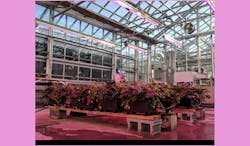Horticultural LED fixtures have reportedly reached efficacies of up to 3.2 µmol/J in 2019. Integrated with environmental sensing and control technologies, new lighting systems offer controlled environment agriculture (CEA) growers a wide range of benefits from lower operational costs to improved crop biomass yield. Spectrum manipulation, as is widely known, can be used to control crop morphology, development, and production of high-value nutritional compounds like pigments and secondary metabolites.
At GLASE (the Greenhouse Lighting & Systems Engineering Consortium), however, we find that technology implementation, such as integrating new lighting control systems, is not always a simple process. In many ways, the potential benefits of new lights and integrated systems demonstrated in the laboratory are not readily available for commercial CEA growers nor are they able to be duplicated outside the lab. The lack of benchmark information and limited industry standards make it very challenging for greenhouse growers and indoor farmers to decide which technology to choose and how to transition from the legacy high-pressure sodium (HPS) technology.
To help facilitate technology transfer from the lab to commercial greenhouses and indoor farms, GLASE has developed an outreach program to support manufacturers and CEA growers by providing scientific-based information and industry insights with the goal of getting new technologies to market — and much faster. The outreach program will help bridge the ever-widening gap between academia and industry, keeping growers and manufacturers informed about the latest technologies through a series of webinars featuring new scientific and technological innovations and best practices in the CEA industry.
Right now, we are implementing two new research LED modules that were developed at the LESA Center at Rensselaer Polytechnic Institute (RPI) in growth chambers at RPI and greenhouses at Cornell University. The two compatible horticultural fixtures were designed to provide GLASE researchers full control over light spectrum and intensity. The new fixtures can be integrated to environmental and physiological sensing, allowing for plant-based feedback controls. After validation at the research greenhouses, the newly-developed lighting algorithms and controls strategies will be piloted in two commercial greenhouses in New York to further optimize the Light and Shade System Implementation (LASSI) technology advantages.
LASSI provides greenhouse growers precise daily light integral (DLI) control by dynamically adjusting the amount of supplemental light provided based on external lighting conditions to ensure crops receive the same amount of light every day. Two new integrated control systems are in development: the CO2-LASSI which integrates lighting control and CO2 supplementation that optimizes plant light use efficiency, and the Day-Ahead Market (DAM) LASSI, which accounts for fluctuations in energy price to decide the most economic time of the day to provide supplemental light.
The webinars will allow commercial CEA growers the opportunity to see the benefits offered by advanced lighting controls systems in operation before investing heavily to overhaul their greenhouses with the wrong lighting application or platform to help them better manage and offset the high level of risk involved in adopting new technologies. They will also have the opportunity to connect with the industry experts and growers who are using the technology.
We are also tapped into the National Greenhouse Database where baseline information about energy use, crop production, and equipment used in greenhouse innovation is collected and stored anonymously. The data gathered through this tool gives greenhouse operators access to the most comprehensive collection of resources and CEA criteria to measure their own operations against other greenhouses of similar size and configuration.
We are excited because the value of the data increases exponentially when there are as many contributors and participants inputting as much information as possible. Trends gleaned from the collective data can help shape future state, federal or utility-sponsored energy efficiency programs, and funding for innovations in greenhouse lighting and energy efficiency technologies. It will also provide technology manufacturers with guidance on new product development, solutions, and standards needed to address the challenges in the CEA industry.
Editor’s note: Neil Mattson of GLASE and Cornell will deliver the Keynote at this year’s Horticultural Lighting Conference in Denver, CO. Mattson will cover GLASE research and collaborations in developing energy-efficient horticultural lighting and how to integrate the resulting technologies for spectrum-optimized production in controlled environment agriculture. View the latest conference program and join us Oct. 31 for the day-long event.
Get to know our expert
ERICO MATTOS is executive director of the GLASE Consortium at Cornell University. He received a degree in agronomic engineering from the University of São Paulo, Brazil, and joined the University of Georgia’s PhD program in crop and soil sciences in 2009. Mattos completed graduate studies through Singularity University in 2012. He co-founded a horticultural lighting company in 2013 and has co-authored two technology patents on the phase synchronizing pulse amplitude modulation fluorometer.





